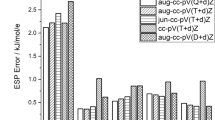Abstract
A prospective study of aqueous solvation energies was done using the SM8 and Zap TK models for a variety of geometries. CM4M charges calculated with M06 and M06-2X were found to yield similar results for the SM8 model. Zap TK calculations were primarily done with AM1BCC charges but limited attempts to use charges derived from DFT showed promise. The OMEGA application quickly generated conformations that performed well with both solvation models, while the use of computationally expensive DFT optimized geometries yielded increased RMSE and MSE. It is shown that increasing levels of gas phase geometry optimization yield increasingly unfavorable solvation energy for single conformer models.





Similar content being viewed by others
References
Geballe MT, Skillman AG, Nicholls A, Guthrie JP, Taylor PJ (2010) The SAMPL2 blind prediction challenge: introduction and overview. doi:10.1007/s10822-010-9350-8
Feynman RP (2005) The pleasure of finding things out: the best short works of Richard P. Feynman. Basic Books, New York
Toolkits 1.7.0-3 (2009) OpenEye Scientific Software, Inc., Santa Fe
Cramer CJ, Truhlar DG (2008) A universal approach to solvation modeling. Acc Chem Res 41:760–768
Nicholls A, Wlodek S, Grant JA (2009) The SAMP1 solvation challenge: further lessons regarding the pitfalls of parametrization. J Phys Chem B 113:4521–4532
Chamberlin AC, Cramer CJ, Truhlar DG (2008) Performance of SM8 on a test to predict small-molecule solvation free energies. J Phys Chem B 112:8651–8655
Marenich AV, Cramer CJ, Truhlar DG (2009) Performance of SM6, SM8, and SMD on the SAMPL1 test set for the prediction of small-molecule solvation free energies. J Phys Chem B 113:4538–4543
Zhao Y, Truhlar DG (2007) The M06 suite of density functionals for main group thermochemistry, thermochemical kinetics, noncovalent interactions, excited states, and transition elements: two new functionals and systematic testing of four M06-class functionals and 12 other functionals. Theor Chem Acc 120:215–241
Halgren TA (1996) Merck molecular force field. I, II, III, IV, and V. J Comput Chem 17:490–641
Halgren TA (1999) MMFF VI. MMFF94s option for energy minimization studies. J Comput Chem 20:720–729
Ribeiro RF, Marenich AV, Cramer CJ, Truhlar DG (2010) Prediction of SAMPL2 aqueous solvation free energies and tautomeric ratios using the SM8, SM8AD, and SMD solvation models. doi:10.1007/s10822-010-9333-9
Omega 2.3.2 (2009) OpenEye Scientific Software, Inc., Santa Fe
Szybki 1.3.2 (2009) OpenEye Scientific Software, Inc, Santa Fe
QuacPac 1.3.1 (2008) OpenEye Scientific Software, Inc, Santa Fe
Jakalian A, Bush BL, Jack DB, Bayly CI (2000) Fast, efficient generation of high-quality atomic charges. AM1-BCC model: I. Method. J Comput Chem 21:132–146
Jakalian A, Jack DB, Bayly CI (2002) Fast, efficient generation of high-quality atomic charges. AM1-BCC model: II. Parameterization and validation. J Comput Chem 23:1623–1641
Olson RM, Marenich AV, Cramer CJ, Truhlar DG (2007) Charge model 4 and intramolecular charge polarization. J Chem Theory Comput 3:2046–2054
Frisch MJ, Pople JA, Binkley JS (1984) Self-consistent molecular orbital methods 25. Supplementary functions for Gaussian basis sets. J Chem Phys 80:3265
Higashi M, Marenich A, Olson R, Chamberlin AC, Pu J, Kelly CP et al (2008) GAMESSPLUS version 2008-2, University of Minnesota, Minneapolis
Schmidt MW, Baldridge KK, Boatz JA, Elbert ST, Gordon MS, Jensen JH et al (1993) General atomic and molecular electronic structure system. J Comput Chem 14:1347–1363
Hehre WJ, Radom L, Schleyer PR, Pople JA (1986) Ab initio molecular theory. Wiley, New York
Nicholls A, Wlodek S, Grant JA (2010) SAMPL2 and continuum modeling. doi:10.1007/s10822-010-9334-8
Mobley DL, Dill KA, Chodera JD (2008) Treating entropy and conformational changes in implicit solvent simulations of small molecules. J Phys Chem B 112:938–946
Author information
Authors and Affiliations
Corresponding author
Electronic supplementary material
Below is the link to the electronic supplementary material.
Rights and permissions
About this article
Cite this article
Ellingson, B.A., Skillman, A.G. & Nicholls, A. Analysis of SM8 and Zap TK calculations and their geometric sensitivity. J Comput Aided Mol Des 24, 335–342 (2010). https://doi.org/10.1007/s10822-010-9355-3
Received:
Accepted:
Published:
Issue Date:
DOI: https://doi.org/10.1007/s10822-010-9355-3




